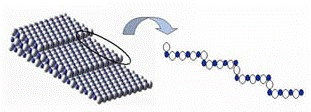Chemistry, Department of: Faculty Series

Marjorie A. Langell Publications
Document Type
Article
Date of this Version
7-1-1999
Abstract
Nickelocene adsorption onto Ag(100), Ni(100), and NiO(100)/Ni(100) surfaces was studied with x-ray photoelectron spectroscopy and high-resolution electron energy loss spectroscopy at 135 K for monolayer and multilayer coverages of NiCp2. On the relatively inert Ag(100) surface, nickelocene physisorbs molecularly, with its molecular axis perpendicular to the surface plane. Exposure to the reactive Ni(100) surface results in the decomposition of nickelocene into acetylene and acetylene-like fragments and, when this surface is warmed to 273 K, carbide contamination is observed. There is evidence for double-bond carbon on nickelocene-exposed NiO(100), and vinyl and propenyl fragments are the most likely decomposition products on this surface. At very large exposures, adsorbed nickelocene is molecularly condensed and, therefore, produces similar thin films on all three surfaces.


Comments
Published by American Vacuum Society. J. Vac. Sci. Technol. A Vol. 17, No. 4, Jul/Aug 1999. ©1999 American Vacuum Society. Permission to use.